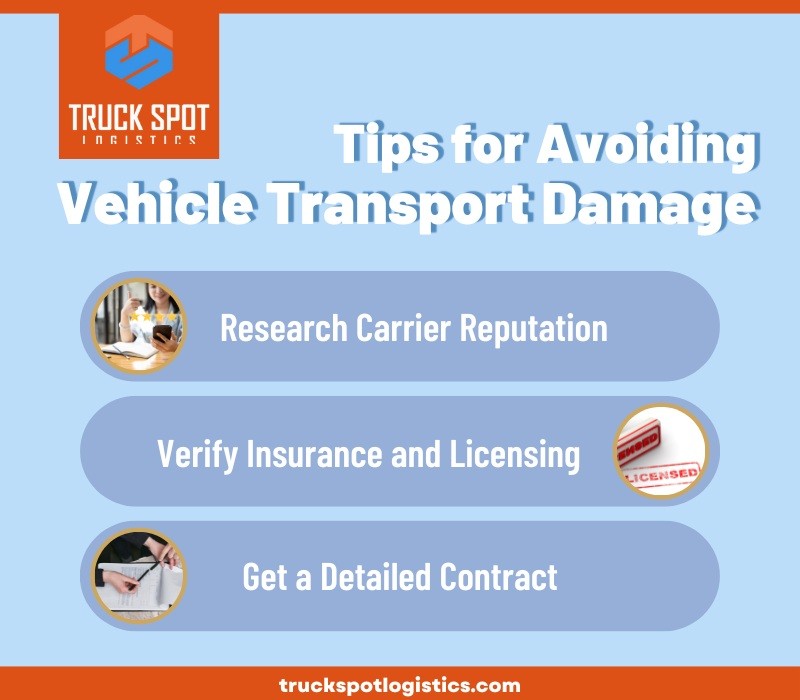Discovering your vehicle has suffered damage in transit can be a major setback, whether you’re relocating, selling, or shipping a car for other reasons. In the vast landscape of auto transport, incidents of car damaged in transit, while not the norm, can occur, leaving vehicle owners in a dilemma of insurance claims and transport claims.
This is where TruckSpot Logistics steps in—not just as a platform for comparing auto transport rates but as a guide through the tumultuous aftermath of auto transport damage. This article is your roadmap to navigating vehicle transport damage, from initial assessment and documentation to filing a robust insurance claim and choosing the right transport service to minimize future risks.
With TruckSpot Logistics by your side, you’re not just shipping your car; you’re ensuring its safety every mile of the journey.
Spotted the Damage: What to Do Immediately
Discovering your car has been damaged in transit is a gut punch. But taking swift and deliberate action is crucial to protect your rights and ensure a smooth insurance claim (or transport claim) process. Here’s your step-by-step guide:

Important Note: Most carriers have strict deadlines for filing damage claims. Check your contract or their website for the specific timeframe. The Federal Motor Carrier Safety Administration (FMCSA) also provides guidelines on resolving freight loss and damage claims.
Filing a Transport Claim: Your Roadmap to Resolution
The claim process can seem daunting after the stress of discovering vehicle transport damage. Understanding the steps and your options gives you the best chance of a fair outcome.

What if the Carrier Denies Responsibility?
Unfortunately, disputes happen. If you’re confident the damage occurred during transport, you have options:
Insurance Claim: Protecting Yourself and Your Vehicle
Understanding the different types of insurance that might come into play with auto transport damage is key to ensuring you’re financially protected.

Important Questions to Ask
Tips
Knowing your coverage options gives you greater control if your car is damaged in transit. Let me know if you’d like me to move on to the final section about preventing problems in the first place!
Prevention is Key: Choosing the Right Auto Transport Service
The best way to avoid the headache of vehicle transport damage is to minimize the risk from the outset. Choosing a reputable and well-insured carrier greatly increases your chances of a smooth transport experience.

Having your car damaged in transit is undeniably stressful. However, knowing your rights, understanding insurance, and taking immediate action gives you the best possible chance of getting your vehicle repaired and back on the road.The choice of transport company plays a huge role in preventing damage. TruckSpot Logistics simplifies the selection process, empowering you to focus on moving your vehicle safely and without surprises.
FAQs
Will shipping a high-value or classic car cost more?
Often, yes. Carriers may charge extra for shipping high-value vehicles, and you’ll likely want supplemental insurance to cover its full value. TruckSpot Logistics can help you find carriers specializing in luxury car transport.
What if the damage to my car isn’t immediately obvious?
Sometimes car damage in transit might be internal or only become apparent after you start driving. Most carriers give you a short window after delivery (usually 24-48 hours) to report concealed damage. Inspect the car thoroughly and take it for a test drive as soon as possible.
Is there a standard amount insurance covers for vehicle transport damage?
Unfortunately not. The minimum liability coverage required by law is low. Carriers may offer additional levels of insurance, but the maximum payout varies widely. This is why it’s so important to ask about a carrier’s coverage limits before booking.
My car was already slightly damaged before shipping, will this affect my claim?
Yes. Pre-transport inspections are crucial for this reason. Carriers will note any existing damage on the Bill of Lading. Failing to document this prior to transport makes it harder to prove any new damage was caused by them.
What if the carrier disputes my transport claim?
First, gather as much evidence as possible (photos, estimates, independent assessment). Try negotiating directly with the carrier’s insurer. If that fails, you can file a complaint with the Better Business Bureau (BBB) or the Federal Motor Carrier Safety Administration (FMCSA).
Do all auto transport companies offer the same level of insurance coverage?
No! Federal minimums exist, but carriers can have additional coverage. That’s why it’s crucial to compare carriers on TruckSpot Logistics, we are paying attention to work with the best only.













